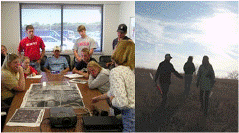Environmental and Sustainability Studies Program

Department of Environmental Studies: Undergraduate Student Theses
Date of this Version
Spring 5-2013
Document Type
Thesis
Abstract
Nematodes are some of the most diverse and abundant animals on Earth. These microscopic invertebrates are found in virtually all terrestrial and aquatic habitats. While their abundance and diversity of form is well documented, their genetic diversity and distribution is largely unknown (Boag and Yeates, 1998). How this diversity is distributed across continents, ecoregions, and landscapes is still being discovered.
There are two primary objectives of this project. First, we wanted to determine how patterns of nematode diversity are distributed within and among tall grass prairies. Additionally, we wanted to generate new knowledge about belowground prairie diversity. One component to this was simply determining characteristics of the nematode communtities found within the prairie. Tall grass prairies are known to harbor high levels of plant diversity, so does the belowground nematode diversity reflect this aboveground diversity? These objectives were approached through an intensive nematode sampling survey of 9 Mile Prairie, followed by DNA analysis.

